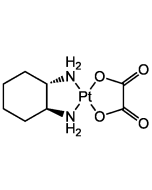Cookie Policy: This site uses cookies to improve your experience. You can find out more about our use of cookies in our Privacy Policy. By continuing to browse this site you agree to our use of cookies.
AdipoGen Life Sciences
Cisplatin
As low as
40
CHF
CHF 40.00
In stock
Only %1 left
AG-CR1-3590-M05050 mgCHF 40.00
AG-CR1-3590-M250250 mgCHF 120.00

| Product Details | |
|---|---|
| Synonyms | cis-Diamminedichloroplatinum (II); Neoplatin; CDDP; cis-DDP; NSC119875; NK 801; TR170 |
| Product Type | Chemical |
| Properties | |
| Formula |
Cl2H6N2Pt |
| MW | 300.0 |
| Merck Index | 14: 2317 |
| CAS | 15663-27-1 |
| RTECS | TP2450000 |
| Purity Chemicals | ≥98% |
| Appearance | Yellow solid. |
| Solubility | Soluble in DMF or DMSO. Sparingly soluble in water. Insoluble in ethanol. |
| Other Product Data |
Note: In aqueous solution cis-trans isomerization of cisplatin occurs. Isomerization is increased at elevated temperatures. Stability of cisplatin in aqueous solutions was enhanced by increasing the sodium chloride (NaCl) concentration to 0.9% and was adversely affected in alkaline solutions such as sodium bicarbonate solutions. Further, even though soluble in DMSO, we do not recommend to dissolve cisplatin in DMSO. DMSO inserts itself into the ligand. It is recommended to prepare all solutions fresh and protected from light. |
| InChi Key | LXZZYRPGZAFOLE-UHFFFAOYSA-L |
| Smiles | N[Pt](N)(Cl)Cl |
| Shipping and Handling | |
| Shipping | AMBIENT |
| Short Term Storage | +4°C |
| Long Term Storage | +4°C |
| Handling Advice |
Keep cool and dry. Protect from light and moisture. |
| Use/Stability | Stable for at least 2 years after receipt when stored at +4°C. |
| Documents | |
| MSDS |
 Download PDF Download PDF |
| Product Specification Sheet | |
| Datasheet |
 Download PDF Download PDF |
Description
- Potent platinum-based antineoplastic agent [1, 10].
- Anticancer compound [1]. Forms inter- and intrastrand DNA adducts/crosslinks, consequently blocking DNA replication and transcription and inducing cell death [2, 12, 13, 15].
- Nephrotoxic when used in vivo [3].
- Potent chemoimmunotherapeutic. Stimulates the immune responses by activating macrophages and other cells of the immune system [4, 6].
- Apoptosis inducer via p53-dependent and -independent mechanisms [5, 7, 8].
- Induces apoptosis through caspase-3 activation and XIAP expression inhibition [9, 14].
- Targets other proteins and enzymes [10].
- Non-competitive NHE-1 inhibitor, an archetypal, membrane-bound mechanosensitive sodium-hydrogen ion transporter [16].
Product References
- Antitumor action of cis-dichlorobis(methylamine)platinum(II): G.R. Gale, et al.; J. Natl. Cancer Inst. 51, 1227 (1973)
- Preliminary characterization of the adducts formed between the antitumor compounds cis-Pt(NH3)2Cl2 and DNA: N.P. Johnson; BBRC 104, 1394 (1982)
- Plasma platinum levels: relationship to cisplatin dose and nephrotoxicity: A.B. Campbell, et al.; Cancer Treat. Rep. 67, 169 (1983)
- Immune response of mice exposed to cis-diamminedichloroplatinum: O. Bagasra, et al.; Cancer Immunol. Immunother. 19, 142 (1985)
- Cisplatin induces a persistent activation of JNK that is related to cell death: I. Sanchez-Perez, et al.; Oncogene 16, 533 (1998)
- Antigen presentation by cisplatin-activated macrophages: role of soluble factor(s) and second messengers: R.A. Singh & A. Sodhi; Immunol. Cell Biol. 76, 513 (1998)
- Cisplatin-induced apoptosis in human proximal tubular epithelial cells is associated with the activation of the Fas/Fas ligand system: M.S. Razzaque, et al.; Histochem. Cell Biol. 111, 359 (1999)
- The tyrosine kinase c-Abl regulates p73 in apoptotic response to cisplatin-induced DNA damage: J.G. Gong, et al.; Nature 399, 806 (1999)
- Cisplatin (CDDP) specifically induces apoptosis via sequential activation of caspase-8, -3 and -6 in osteosarcoma: K. Seki, et al.; Cancer Chemother. Pharmacol. 45, 199 (2000)
- What is the "best" platinum: cisplatin, carboplatin, or oxaliplatin? J. Lokich; Cancer Invest. 19, 756 (2001)
- Biomolecular targets for platinum antitumor drugs: R.N. Bose; Mini Rev. Med. Chem. 2, 103 (2002)
- Cisplatin: mode of cytotoxic action and molecular basis of resistance: Z.H. Siddik; Oncogene 22, 7265 (2003)
- New clues for platinum antitumor chemistry: Kinetically controlled metal binding to DNA: J. Reedijk; PNAS 100, 3611 (2003)
- Cisplatin inhibits the expression of X-linked inhibitor of apoptosis protein in human LNCaP cells: T. Nomura, et al.; Urol. Oncol. 22, 453 (2004)
- Inhibition of transcription by platinum antitumor compounds: R.C. Todd & S.J. Lippard; Metallomics 1, 280 (2009)
- Nongenomic effects of cisplatin: acute inhibition of mechanosensitive transporters and channels without actin remodeling: N. Milosavljevic, et al.; Cancer Res. 70, 7514 (2010)
- RANKL signaling sustains primary tumor growth in genetically engineered mouse models of lung adenocarcinoma: J. Faget, et al.; J. Thoracic Oncol. 13, 387 (2017)
- GADD45α-targeted suicide gene therapy driven by synthetic CArG promoter E9NS sensitizes NSCLC cells to cisplatin, resveratrol, and radiation regardless of p53 status: Q. Shi, et al.; Onco Targets Ther. 12, 3161 (2019)
- Single-event tandem ICP-mass spectrometry for the quantification of chemotherapeutic drug-derived Pt and endogenous elements in individual human cells: T. Liu, et al.; Analyt. Chim. Acta 1177, 338797 (2021)
- The Hippo pathway kinases LATS1 and LATS2 attenuate cellular responses to heavy metals through phosphorylating MTF1: H. Han, et al.; Nature Cell Biol. 24, 74 (2022)
- Generation of transgenic mice expressing a FRET biosensor, SMART, that responds to necroptosis: S. Murai, et al.; Nature Commun. Biol. 5, 1331 (2022)







